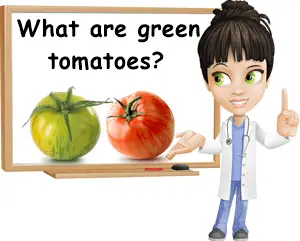Green tomatoes are just unripe tomatoes. Versus common ripe tomatoes of the red variety which are high in lycopene, green tomatoes have virtually no lycopene but are high in chlorophyll instead.
Green tomatoes are a good source of vitamin K and dietary fiber and have antioxidant and antiaging benefits. Despite fears of toxicity, it’s safe to eat green tomatoes both raw and cooked, as well as nutritious and a source of health benefits.
What are green tomatoes?
Green tomatoes are essentially unripe tomatoes. All tomatoes are green first, but ripen and become red, pink-red, yellow, orange, purple, black or bicolor – blushed or striped with red and yellow, purple with green or red with green. There are also varieties of tomato that have green fruit when ripe (e.g. the Green Zebra cultivar), but these too start out green. Overall, the standard green tomato is any unripe tomato that is still green inside and out and has yet to soften and sweeten, irrespective if it’s underdeveloped or fully grown in size, from a red cultivar or another color.

What do green tomatoes look like?
Green tomatoes may differ slightly in appearance depending on their developmental stage. The botanical fruit and culinary vegetable starts out small and gradually increases in size over the growing season. Depending on the cultivar, the shape may vary from round to pear-shaped to irregular. Some green tomatoes are a pale green color (also called white tomatoes), others are a greenish yellow and others a more yellowish green. Even at this stage, green tomatoes are edible.
Are green tomatoes poisonous?
Many people wonder if green tomatoes are safe to eat or if are they toxic or poisonous. Eating green tomatoes in reasonable amounts, that is, a normal food intake, should not pose any health risks short or long-term unless the person eating them is allergic to tomatoes.
However, there is some truth to this concern as green tomatoes and other parts of the tomato plant except for the ripe, colored fruit are mildly toxic.
The tomato plant stem, leaves and, to a lesser extent, the unripe, green tomato fruit contain toxic chemicals called glycoalkaloids (e.g. tomatine, solanine).
But while the plant stem and leaves are likely to be poisonous if consumed even in normal food amounts, the unripe green tomatoes are generally safe to eat in normal food amounts, both raw and cooked or otherwise processed (e.g. pickled). Not just this, but green tomatoes have scientifically proven anticancer properties.
Learn more about the anticancer properties of tomatoes.
Can you eat raw green tomatoes?
You can eat raw green tomatoes and do so safely so long as you are not allergic to the fruit, although it’s likely you’ll prefer them cooked. Green tomatoes are edible all throughout their unripened stage, irrespective of size, consistency and color, although the closer they get to a more ripened state, the better they taste.
Unripe green tomatoes do contain naturally occurring toxins such as tomatine and solanine, but in amounts small enough to not pose any health risks given a normal food intake. As a parallel, capsaicin and other capsaicinoids responsible for the spicy and sweet flavors of peppers are also toxins and they are similar to those in unripe and ripe tomatoes, but that doesn’t make peppers poisonous raw, cooked, dried or otherwise prepared.

What do green tomatoes taste like?
The taste of green tomatoes can very depending on how unripe they are. Overall green tomatoes taste savory, a little bit tangy and have a firm, somewhat hard flesh with a crisp, juicy texture. Green tomatoes are not sweet; instead, they taste a little bitter, likely because of the naturally occurring glycoalkaloid components in the plant. Green tomatoes are perfectly edible raw, cooked or pickled, and a source of good nutrition and varied health benefits despite being unripe.
Green tomatoes nutritional information
Green tomatoes are high in chlorophyll, an antioxidant present naturally in green plants and algae, and in common foods such as parsley, spinach, green cabbage, arugula, asparagus, green bell peppers and more foods.
Chlorophyll has antioxidant properties, is a natural anti-inflammatory agent and boasts antiaging benefits.
Because of their color, green tomatoes have little to no lycopene and beta-carotene common in ripe tomatoes of the red variety. Green tomatoes are also a good source of potassium, magnesium, manganese, vitamins B1, B3, B6, C, E and especially vitamin K and have a good content of dietary fiber for constipation relief and digestive health.
Green tomatoes: how to eat them
If your tomatoes aren’t turning red anymore because their season is coming to an end and you are left with buckets of green tomatoes on your hands, then you may be wondering what exactly to do with them. Lucky for you, a green tomato is such a versatile food that it lends itself to many wonderful recipes, including:
Green tomato savory sauce (chutney or relish)
Finely chop sweet yellow onions and fry in vegetable oil until golden brown. Add finely chopped green tomatoes and stew until soft. Season with salt, pepper, fresh parsley and serve on freshly-baked bread. You can also add ripe red tomatoes or red pepper right after the onion and cook for 10 minutes or so for extra flavor.
Fried green tomato slices
A classic recipe with a long tradition, fried slices of unripe green tomatoes are a popular choice of a meal for late summer and early fall. You can fry green tomatoes plain, as they are, or cover in batter or breadcrumbs first for a complimenting crunch, seasoned simply with salt and pepper. Fried green tomatoes are a traditional recipe from the Balkan region and also Southern US.
Pickled green tomatoes
Balkan-inspired green tomato pickles are made from either underdeveloped, whole, green tomatoes or matured, but still unripe green tomato wedges. Water, vinegar, oil, salt, dill, mustard seeds and laurel leaves all contribute to the flavor of the pickles.
